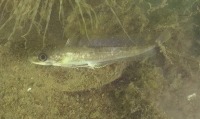
(Photo: Chris Harvey-Clark)
Red Hake
Urophycis chuss
This fish has an elongate body that tapers toward its tail. Usually red to olive-brown on its back with a paler abdomen. Often has darker spots on its side and darker coloured fins. Small head with a pointed snout, large eyes and a small barbel under the jaw. The pelvic fins are just behind the head and reduced to two antennae-like rays. Triangular dorsal fin with its third ray at least twice as long as the others. Long thin second dorsal and anal fins.
Authority
Walbaum, 1792
Classification Details
Phylum: Chordata (chordates); Subphylum: Vertebrata (vertebrates); Class: Actinopterygii (ray-finned fishes).
Habitat
A bottom-dwelling species which occurs on sand and mud seabeds. Juveniles are found in shallow coastal waters. Adults occur in depths of 35-680 metres but usually 72-124 metres. Found in the western Atlantic from Newfoundland to North Carolina.
Diet
Predator. They mostly feed at night. They use chemical and movement sensing structures in their chin barbel, dorsal fin ray to seek out prey. Juveniles eat small crustaceans such as amphipods, copepods, shrimps, and krill. Adults also mainly eat crustaceans including shrimp, krill and crabs but may also eat other invertebrates and fish.
Reproduction
Separate sexes. Spawning occurs between July and September. They have buoyant eggs which float in the seawater. The larvae hatch when they are 1.8 to 2 millimetres long. They are pelagic for two to three months before settling to the seabed when they are around 30 millimetres long. Red hake are fast-growing and have a short life span. They are sexually mature at two years old and 30 cm long. Few adults survive longer than eight years.
Fun Facts
Juvenile hake are often found under or in the shells of live or dead scallops. They can live in the shells until they are 13.5 centimetres long. They may also hide under shells, sponges, and rocks. This behaviour protects them from predators.
References
Bigelow HB and Schroeder WC (2002) Fishes of the Gulf of Maine. Fishery Bulletin of the Fish and Wildlife Service 53, online edition.
Scott WB and Scott MG (1988) Atlantic fishes of Canada. Canadian Bulletin of Fisheries and Aquatic Sciences 219, 731p.
Steiner WW, Luczkovich JJ, Olla BL (1982) Activity, shelter, usage, growth and recruitment of juvenile red hake Urophycis chuss. Marine Ecology Progress Series 7, 125-135.


